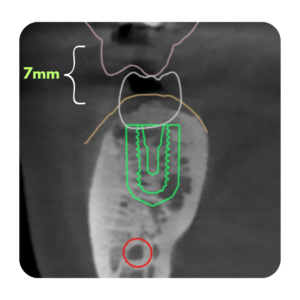So, we all want our impressions to be as accurate as possible.
And something that I’ve taken for granted up until now, is that for bridges open tray impression technique with splinted copings is best.
I’ll take a single implant impression with closed tray or with a scan. But for bridges, I always default to OPEN TRAY SPLINTED.
Up until now, I’ve always said “it’s the prosthodontist in me that makes me do it.”
But after doing some light reading this morning, I now realize how intellectually inadequate that statement is.
It’s a good thing I came across this Systematic Review by Yun Ma et al 2022.
We can all agree that we want all of our restorations to have minimal marginal misfit–even for implants. A marginal gap can lead to biological complications stemming from bacteria accumulation. It can also lead to prosthetic complications such as screw loosening or prosthetic fracture.
Another interesting thing to look at is prosthesis strain. If a prosthesis does not fit perfectly (passively), it can actually take on some strain as it is installed onto the implants. This strain is a sign of imperfect fit.
[mepr-show if=”loggedout”] Login or signup to Implant Ninja Dojo to read the rest of this article.[/mepr-show]
[mepr-show if=”loggedin”] This Systematic Review looked at 5 in vitro (benchtop) studies and was able to draw some conclusions about marginal gap and about prosthesis strain. These studies specifically looked at divergent implants only.
In terms of Marginal Gap, there was a difference. Yun Ma determined that there was a statistically significant difference. If you don’t splint your open tray impression copings on divergent implants, based on these studies, you will have a statistically significant increase in marginal gap between your prosthesis and your implant.
Now let’s look at some studies that evaluate strain.
The two that were included in this systematic review were from Choi et al and Dang et al. While there was a difference in the amount of strain in the splinted versus non-splinted, it was NOT statistically significant. (Dang et)
So we are left with 2 pieces of information.
First, the strain criteria didn’t really yield us much info to work with. It is notable to mention that the strain studies looked at smaller degrees of implant divergence (8 and 15) whereas the gap studies evaluated implants that had a greater degree of divergence (10 and 30) so we shouldn’t put a fork in it yet.
Maybe strain would have been significant with greater degrees of divergence.
Now on to the good stuff…
Yes, marginal gap will be bigger if we do not splint our impression copings for divergent implants.
How much bigger? 13.34 on average
This is based on 2 studies only, so don’t put any weight on the actual number here. Just use this as a ballpark.
Now, is 13.34 CLINICALLY significant? Hmmm, maybe not. A study by Jemt 1996 suggest that 100 microns is a clinically acceptable level of misfit.
Although the data is quantitative, I think it would serve us well to take it in a broader perspective. I don’t think we should dismiss the 13 microns as trivial. Because the truth is that in any dental procedure, there are many opportunities of introducing innaccuracy. And our jobs is to try, whenever possible, to reduce our inaccuracies. By improving our accuracy a little here and a little there, we can realistically achieve a little more clinical excellence that we can be proud of. [/mepr-show]




Responses